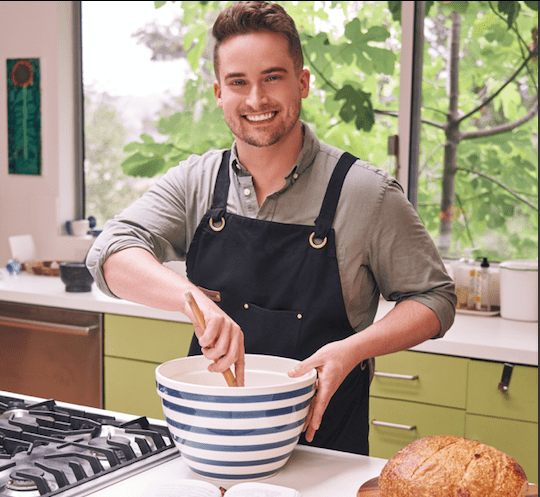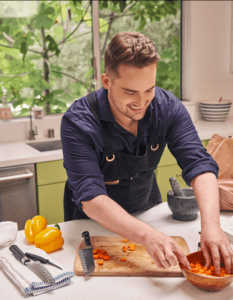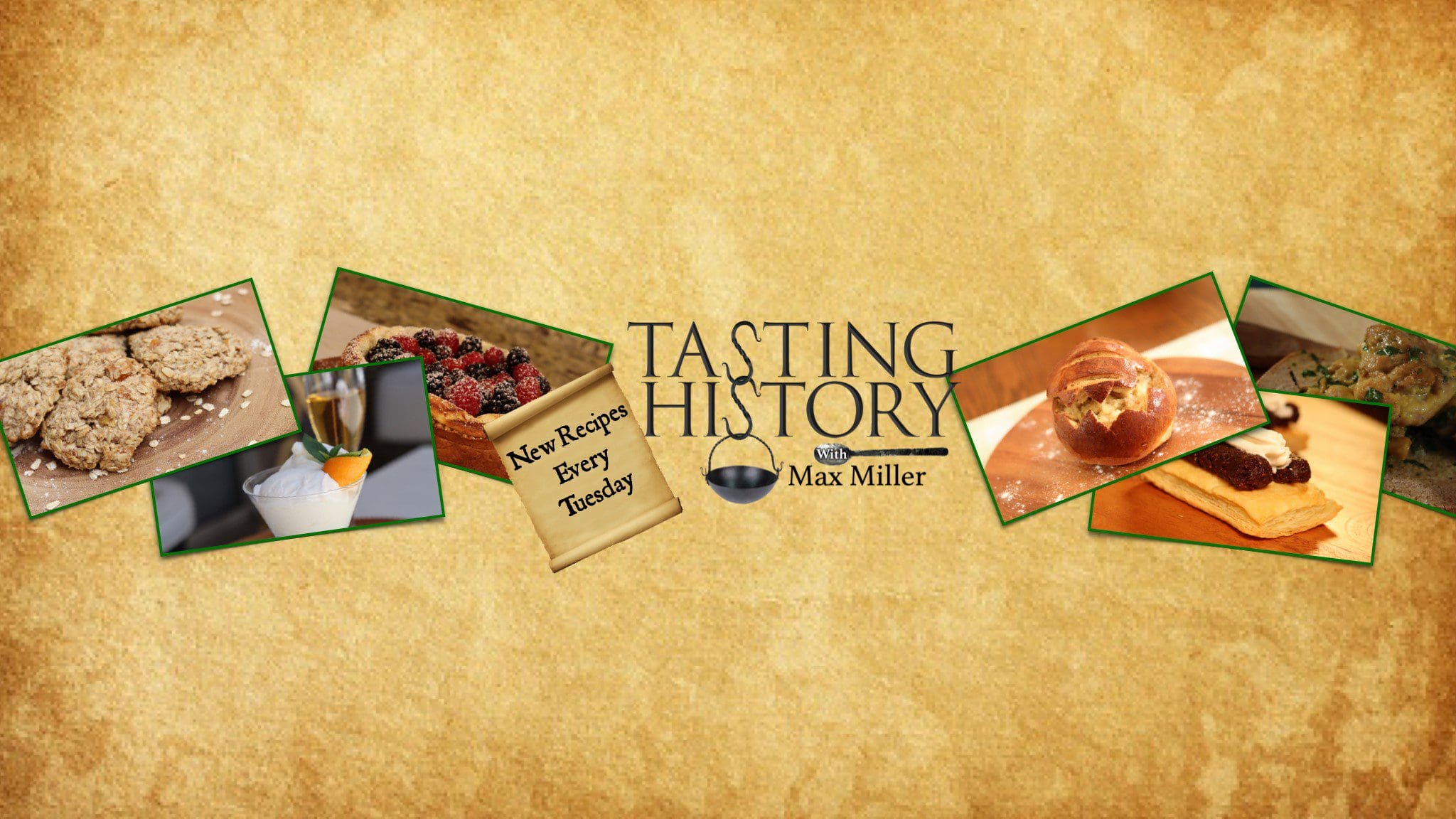If you love food and history, you should check out Max Miller’s YouTube series Tasting History. Every Tuesday, Max Miller takes us through historical recipes and their origins.
We recently sat down with him to find out what inspires him and how he comes up with new topics.
How long have you been doing Tasting History?
Max Miller: My first episode was the last week of February.
When did you get into cooking as a hobby?
Max Miller: It will be six years this Christmas. I was with a friend. We went on vacation to Disney World. Because I worked for Disney, we got to go for free. She was sick the entire time, so we really didn’t do anything. We would go to the park for 45 minutes and then go back to the hotel, so we spent the whole time in the hotel watching The Great British Bake Off and I became obsessed with it. I had never cooked anything. I had never even boiled an egg before watching that show but I was so inspired by it. The old episodes were so good at teaching you how to do what they were doing that I went home and I made every single thing that they had made on the show that season. So it was kind of a teach yourself how to bake thing. It’s been going ever since.
Are you mostly baking, or do you do some cooking?
Max Miller: Baking is my background because that’s what I really enjoy doing, but as I’ve been doing the show I’ve been getting a lot more into cooking simply for variety’s sake. I’ve always found cooking for me to be oddly more difficult because the recipes tend to have a lot more leeway. And then add spice to taste … well, I don’t know what it’s supposed to taste like, so I don’t know what you mean.

I’ve got a wonderful book by Thomas Keller. Not only is he one of the greatest chefs in America today, maybe in the world, but he is also one of the best cookbook writers. He has a book on The French Laundry, which has some of the most complicated meals in the world. He walks you through it step by step with so much wonderful background on every single technique that by the end you’ve recreated, maybe a pale imitation, but you’ve recreated something that is sold for 400 dollars a plate at the French Laundry. He’s amazing. I buzzed through a couple of his cookbooks. It though me a lot. I’m sure he would be ashamed to know that my horrible knife skills came from his tutelage.
How did your interest in The Great British Bake Off, or The British Baking Show, as its known here turn into specifically historical recipes?
Max Miller: I’ve always been into history of all times, but on The Great British Bake Off in those early seasons, especially the seasons that never actually aired here and you can’t find them anywhere. In those early seasons, Mel [Giedroyc] and Sue [Perkins], who were the hosts at the time used to do these little history segments. They were like a minute, maybe two minutes. Really, really short. They would talk about the history of whatever dish was being made and they did it with this irreverent humor that they have. Lots of silly puns. That was most definitely at least one source of inspiration for me. I think that’s what actually got me into baking. If I want the show now, I don’t know if I would have the same reaction. It was those history segments because I already loved history, so that was the in for me. Like oh, they’re talking my language about this 18th century cake. Well, I like history. I’m going to create history in my kitchen. That’s how it started.
For tasting history, who are your influences?
Max Miller: Definitely Mel and Sue are huge influence. I think they are both fantastic hosts. I also think Alton Brown is a huge influence on me. His way of bringing food and science together in a rather seamless and fun, entertaining way. Definitely a huge influence. And Bill Nye the Science Guy. I grew up on Bill Nye the Science Guy the TV show. His way of making for, what could be for many people, a very boring subject absolutely not boring and geared towards all age groups. It was a kids show. I remember my dad watched it along with us and enjoyed it just as much.
That’s what I try to do with tasting history. It’s not a kids show, but I get a lot of people saying they are able to watch it with their kids, which is fantastic. I try not to put anything in to crude or crass. I’m pretty G or PG-rated.
How do you come up with ideas for Tasting History?
Max Miller: Lots of ways. Some of them have been through viewers saying “Hey this is a cool dish.” A lot of times it’s not a recipe, so that is where my research gets going. I’m going to find the recipe for this dish that somebody mentioned. Typically, it starts with the recipe. I have lots of old cookbooks and there are so many online. There are lots of projects. The Gutenberg Project and university libraries around the world have put these cookbooks online if you know where to find them. There are hundreds if not thousands. A lot of times they’re not in English. I’m not fluent in a lot of these languages, so there’s a lot of Google translate, painstakingly transcribing over until I get a gist of what they’re talking about. Then, I go to a friend who is fluent and say can you translate this for me. That’s part of the fun. I’ll start with an idea that I want to do a dish with duck from the 18th century from France. That was my inspiration. I just started going through 18th century French cookbooks until I found the word canard on the page. Then it’s alright. Let’s dig into this.

Have you found any recipes where you’re like ‘I’m not going to touch that?’
Max Miller: Lots for all different reasons. Sometimes they’re just too difficult. My longest episode is coming up and that’s 20 minutes. That’s the max. If it’s a dish with 40 ingredients and lots of lots of steps, it maybe just isn’t right for the show. A lot of the times the ingredients are not something I can find or are too expensive. Or the tools aren’t something I have readily available. I just got a pan roasts, so I am able to roast a full animal in the oven. Before that, that was a deal breaker. And then sometimes, it’s an ethical thing. There are some animals that I don’t want to eat. Some of them illegal, not going to be eating whale. There are others where I have thousands of things to choose from, so I’m going to stay away from hedgehog.
What has your favorite recipe been so far?
Max Miller: It’s always the last recipe I did that’s my favorite. Flavor-wise — Parthian chicken. It was a different flavor, completely foreign to anything I had ever eaten. The surprise behind the dish tasting so good is why it’s my favorite. Two of the ingredients smelled horrific. One is fermented fish sauce, Garum. One is Asafetida — it literally means fetid, stinking gum. It smells like death, but when you cook with it, heat it up, it unexpectedly becomes this wonderfully pleasant onion-y but different flavor that you’ve never tried before. I think the surprise of oh this is actually good makes it my favorite.
What food era is most interesting?
Max Miller: Victorian England and America because it’s that transition point between really old food that are completely foreign to us and foods that we would think of as modern. In the Victorian age, you see a melding of those old foods with a lot of ingredients you wouldn’t find today being used in ways that are very relatable to us. It’s just that everything from the Victorian seems to have calves foot jelly or other types of gelatin in them. I don’t know why they were obsessed with it. It’s in everything including some of their alcoholic drinks.
Are there any recipes that hold up surprisingly well?
Max Miller: Lots. Number one is Syllabub. It’s basically boozy whipped cream. I’m not sure what’s not to like. I would think it would be on the menu of fine dining restaurants everywhere. It’s absolutely wonderful and so versatile. In the video, I used white port and flavored it with orange blossom water, but you could flavor it with anything that you want. I made it recently and used a bit of rum. I know people who have used sake and calvados. It’s a blank canvas with sugar that you can paint whatever flavor you want on it. It’s a wonderful dessert. Really simple, easy to make.
If you’re looking to get into the holiday spirit, Tasting History has you covered. Check out Max’s video on Victorian Christmas pudding! If you enjoy it, don’t forget to subscribe to their YouTube Channel.



Max. I wish your roommate weren’t so shy. Can you do an episode on fruitcake and the history of citron? BTW, I am inspired by The Two Fat Ladies, may they rest in peace.
I love your series! You make it all so interesting and you deliver what could be ‘just historical info in a way that often has me laughing outloud as I am madly writing down directions.
Could you please tell me if the artwork at the opening to your videos is something that is actually for sale as a print or simply art created for your series? I just love the expression on the boy next to the seated man, who looks ready to pass out from carb heaven. The look is priceless. Live that scene.
……LOVE that scene. Spellchecker. 🙄